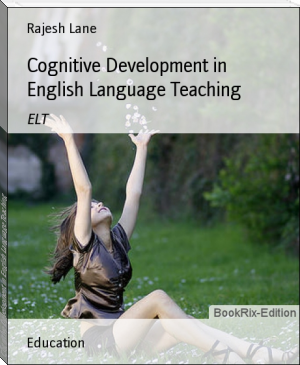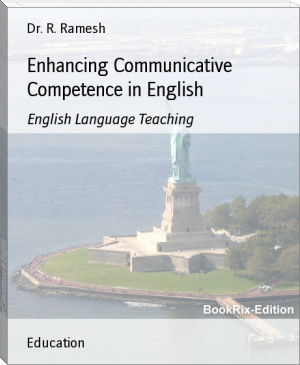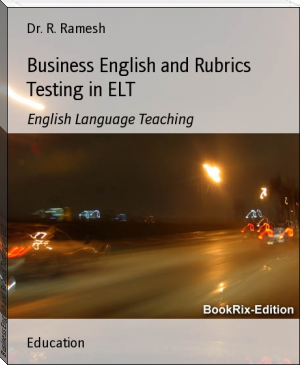Cognitive Development in English Language Teaching by Rajesh Lane (ereader android .txt) 📖

- Author: Rajesh Lane
Book online «Cognitive Development in English Language Teaching by Rajesh Lane (ereader android .txt) 📖». Author Rajesh Lane
The human brain system may be pictured as follows.
According to Asher the adult should proceed to language mastry through right-hemisphere motor activities, while the left-hemisphere watches and learns. “When a sufficient amount of right-hemisphere learning has taken place, the left-hemisphere will be triggered to produce language and to initiate other, more abstract language process”. (Approaches and methods in language Teaching, 91).
Cognitivists believed that, “the problem may be entirely mental, requiring a mental solution; it may involve nothing more than an “explanation” to help the learner “understand” the situation. However, the explanation has to be available in a form in which it can be extended to other words, an explanation which can be generalized”.(”Methods of Teaching English”, Block –II 20).
Cognitivists believe that basically all learning involves the process of generalizing from particular instances.
Any learning experience has to be incorporated into the “cognitive map” or the generalized pattern which the learner is able to abstract from a series of learning experiences. “Learning, therefore, can be thought of as a process of induction; individual experiences contribute to the general pattern of understanding”.(”Methods of Teaching English”, Block –II, 20).
Cognitivists oppose the behaviour method of mechanical grammar drilling and believe that repetition as unproductive. “Repetition and practice have been considerably devalued as language learning devices, and hypothesis-formation and problem-solving have been emphasized. In particular any kind of mechanical drilling is regarded as unproductive today”. (“Methods of Teaching English Block-II”, 30).
American linguist Noam Chomsky has proved that linguistics is a branch of cognitive psychology. Chomsky gives importance to the linguistic competence of the native speaker.
To Chomsky, view of language as a collection of structures was too limited. Instead of concentrating on taxonomic classifications of structures, Chomsky proposed in ‘Aspect of the Theory of syntax’ that “linguistics should develop the rules which would account for these structures. These rules constitute linguistic competence, which is the unconscious knowledge of the ‘ideal speaker-listener’ operating in a completely homogeneous speech community” (The ELT Curriculum, 16).
Hymes turned the attention from the ideal-speaker-listener in a homogeneous speech community to differential competence within a heterogeneous speech community.
Hymes argues that, “we require a theory that can deal with a heterogeneous speech community, differential competence, and the constitutive role of socio-cultural features” (“Introduction to Linguistics, Block-V”, 4).
While answering to linguistic competence Hymes stresses upon communicative competence. The ultimate aim of language is communication. Hymes makes the point by observing that, “the rules of use are not a late grafting, but are acquired from the first years of language acquisition”. His account of communicative competence focuses on language in acquisition. (The ELT Curriculum, 16).
Hyme’s theory of communicative competence proved to be an important influence for the evolution of communicative language teaching. The importance of communicative competence shifted the learning process from grammar form focus to content and communication.
Context determines the meaning of utterances. Language learner has to understand the utterances according to the context. Hymes gives great importance to context. Hymes views the role of context in the interpretation as limiting the range of possible interpretation on the one hand. And on the other as supporting the intended interpretation: “The use of a language form identifies a range of meanings. When a form is used in a context, it eliminates the meanings possible to that context other than those the form can signal: The context eliminates from consideration the meanings possible to the form other than those in the context can support” (Discourse Analysis, 37).
Hymens expanded his views on competence. Hymen’s classical description of competence found in a normal, first language child is; as follows: “He or she acquires competence as to when to speak, when not, and as to what to talk about with whom, when where, in what manner. In short a child becomes able to accomplish a repertoire of speech acts, to take part in speech events, and to evaluate their accomplishments by others”. (Language use Language Teaching and The Curriculum, 285).
Canale and Swain have expanded Hyme’s communicative competence. They provide a theoretical framework for communicative competence to include: grammatical competence, sociolinguistic competence and strategic competence.
Grammatical competence includes the concepts of knowledge of lexical items, and ‘… rules of morphology, syntax, sentence-grammar semantics, and phonology’. Strategic competence concerns repair strategies, both verbal and non verbal, due to a breakdown in communication. A main component of sociolinguistic competence is the notion of socio cultural rules which determine the appropriateness of how utterances are produced and comprehended. (Language use Language Teaching and The Curriculum, 286).
Canale and Swain give much importance to sociolinguistic competence in the process of developing communication: “……On the extent to which certain propositions and communicative functions are appropriate with in a given sociocultural context depending on contextual factors such as topic, role of participants, setting and norms of interaction”. (Language use Language Teaching and The Curriculum, 286).
Second language acquisition is revived by many theoreticians. Theorists propose that the second language can be acquired as first language.
Stephen Krashen an applied linguist sees acquisition as the basic process involved in developing language proficiency. He is of the opinion that the conscious learning of grammatical knowledge that has resulted from instruction, cannot lead to acquisition. Krashen opposes the mechanical-drills of grammar –instruction.
Krashen expects that learners will be able to function adequately in the target situation:
They will understand the speaker of the target language (Perhaps with requests for clarification) and will be able to convey (in a non-insulting manner) their requests and ideas. They need not know every word in a particular semantic domain nor is it necessary that the syntax and vocabulary be flawless but their production does need to be understood. They should be able to make the meaning clear but not necessarily be accurate in all details of grammar. (Approaches and methods in language Teaching, 134).
Krashen and Terrell view language as a vehicle for communicating meanings and messages. Krashen and Terrell state that “acquisition can take place only when people understand messages in the target language”. (Approaches and methods in language Teaching, 130). Here it is make aware that the learner should have the minimum amount of cognition to understand the target language. At the undergraduate level the learners come with the internalized language rules, words, sounds and meanings. It is to note that the problem at UG level is the confusion in the use of appropriate rules and context. The conscious application of the rules makes the learner afraid and frustrated.
If the centre of attention is on the proper use of rules [accuracy], the communication gets less attention. Concentration on rules hinders the learner from practicing effective communication and creativity. When the language is contextualized learner can acquire and use grammar unconsciously.
The Natural order hypothesis deals with acquisition as follows:
“Research is said to have shown that certain grammatical structures or morphemes are acquired before others in first language acquisition of English, and a similar natural order is found in second language acquisition (but not during learning). Similar developmental errors occur in learners no matter what their mother tongue is”. (Approaches and methods in language Teaching, 132).
N.S. Prabhu supports to language acquisition through cognitive process, Prabhu suggests “the notion of deploying language through problem-solving to acquire the grammar of English unconsciously” (Methods of Teaching English, Block p. 70). When a speaker uses language the acquires the language while his collegues and teacher speak. While acquiring language, the learner corrects his wrong understanding of words and usages without the influence of others. When the learner speaks, at an incipient stage s/he may commit mistakes. The wrong use of words would be corrected unconsciously on his own when others speak. Here there is no formal instruction. The mistakes are corrected unconsciously when he acquires the proper usage of language in context.
Krashen points out that the language acquisition is a natural process; He made a sharp distinction between conscious knowledge about language, which is ‘learned’ through formal teaching and which is useful for a very limited range of purpose such as proof reading; and unconscious knowledge, which s ‘acquired’ from natural input which provides the means by which we actually communicate. Krashen emphasized the discontinuity between these two types of knowledge and took the strong position that conscious, learned knowledge cannot be transformed into unconscious knowledge.
It is to understand from Krashan’s view that formal teaching cannot help unconscious acquisition. When the learner is allowed to speak, unconsciously she/he comes to understand the content for context. If the class room is teacher-centered the learner would be passive recipients. When the class is learner-centered the learner can acquire language without inhibition. Naturally learner speaks the language unconsciously. Unconscious use of language rules can help the learner to communicate effectively. Communication should be given due consideration than the rules in the second language.
Wilkins opposes the traditional concepts of structure of grammar and vocabulary. Wilkins contribution was an analysis of the communicative meanings that a language learner needs to understand and express: “Rather than describe the core of language through traditional concepts of grammar and vocabulary, Wilkins attempted to demonstrate the system of meanings that lay behind the communicative uses of language”. (Approaches and Methods in language Teaching, 65)
To facilitate learner’s acquisition of language, rule-free situation should be created. Improving effective communication at the fixed condition on learning and teaching should be eradicated. When the learner is controlled by fixed rules, he cannot create any utterances. It will restrict learner’s productivity.
A rule free, stress free situation is needed to acquire and produce language. Asher recommends stress free language acquisition, that is “reduction of stress as key to success-full language acquisition”. (Approaches and Methods in language Teaching, 97)
One characteristic feature of language is creativity. It is important to convey that the hypothesis of language acquisition is not only to acquire a language, but to produce. Here it is to improve learner’s creativity through his/her cognitive abilities. Through the Researcher’s present study the hypothesis of acquisition and creativity processes of cognitive process can be illustrated as follows:
Learner’s cognition plays a vital role in understanding and developing creativity. Learner acquires language from his peer-group, teacher, society, and from the materials such as computer, newspaper, audio, video aids
 The desire to acquire knowledge about the surrounding world and human society is quite natural and understandable for a person. Life is so developed that an uneducated person will never occupy a high position in any field. Humanity in its mass, and each person individually, develops objectively, regardless of certain life circumstances and obstacles, but with different intensity. The speed of development depends on the quality of training.
The desire to acquire knowledge about the surrounding world and human society is quite natural and understandable for a person. Life is so developed that an uneducated person will never occupy a high position in any field. Humanity in its mass, and each person individually, develops objectively, regardless of certain life circumstances and obstacles, but with different intensity. The speed of development depends on the quality of training.




Comments (0)